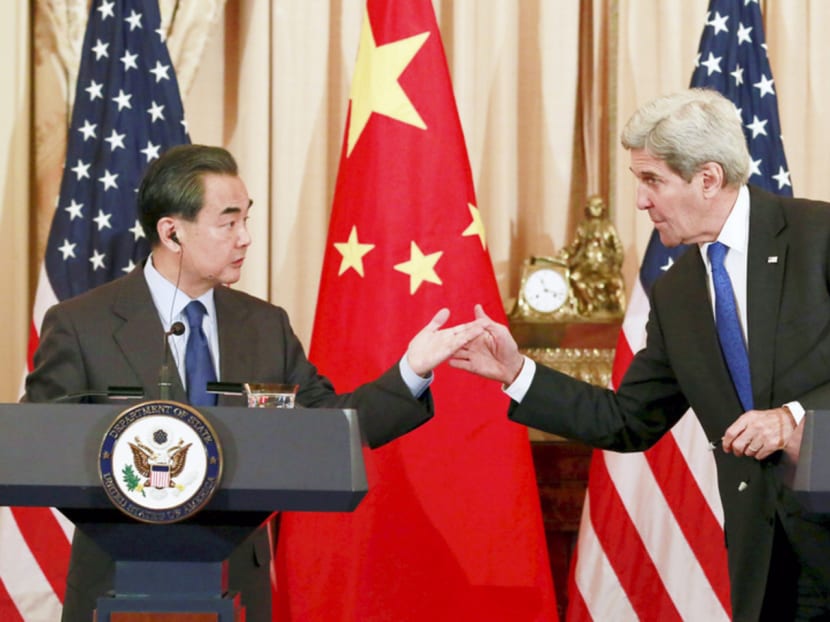US, China stick to hard line over S China Sea
WASHINGTON/BEIJING — The United States and China showed no sign of dialling down tensions in the disputed South China Sea as their top diplomats met in Washington early yesterday, with a senior military commander pledging to increase the number of freedom of navigation patrols with increasing operational complexity in the disputed waters.
WASHINGTON/BEIJING — The United States and China showed no sign of dialling down tensions in the disputed South China Sea as their top diplomats met in Washington early yesterday, with a senior military commander pledging to increase the number of freedom of navigation patrols with increasing operational complexity in the disputed waters.
“We must continue to operate in the South China Sea to demonstrate that the water space and the air above it is international, and not the territory of any nation,” Admiral Harry Harris, head of the US Pacific Command told the US House of Representatives Armed Services Committee yesterday, emphasising that the US must continue to operate in the South China Sea with allies, including Japan and South Korea.
“China’s intent to militarise the South China Sea is as certain as a traffic jam in (Washington) DC. There is no doubt in my mind what their intent is,” Adm Harris said, referring to the capital’s infamous traffic congestion.
At an earlier briefing, Adm Harris pointed to Beijing’s deployment of missiles and radar on disputed islands in the waterway as evidence that China was “clearly militarising the South China (Sea)”, adding that, “You’d have to believe in a flat Earth to think otherwise.”
He also believed that China seeks “hegemony in East Asia”.
The admiral’s latest remarks came after US Secretary of State John Kerry met Chinese Foreign Minister Wang Yi. The duo discussed the tensions in the South China Sea and joint measures to address North Korea’s recent nuclear and missile tests.
This was on the heels of reports that Beijing had sent fighter jets to the disputed waters, days after reports emerged of China’s deployment of surface-to-air missiles, building new radars and airstrips at both the disputed Paracel Island chain and the Spratlys archipelago in the contested waterway.
China claims most of the South China Sea, through which more than US$5 trillion (S$7 trillion) in global trade passes every year. Vietnam, Malaysia, Brunei, the Philippines and Taiwan have rival claims.
The US does not recognise China’s claims and, in recent months, has mounted freedom-of-navigation patrols there.
At a news conference with Mr Kerry early yesterday, Mr Wang said there had been no problems with freedom of navigation. He added that China and countries in the Association of South-east Asian Nations (ASEAN) — several of which have competing claims with China — “have the capability to maintain stability in the South China Sea”.
Mr Wang said militarisation was not the responsibility of one party alone and, in apparent reference to US patrols, said: “We don’t hope to see any more close-up military reconnaissance, or the despatch of missile destroyers or strategic bombers to the South China Sea.”
Mr Kerry said steps by China, Vietnam and others had created an “escalatory cycle”.
“What we are trying to do is break that cycle,” he said. “Regrettably, there are missiles and fighter aircraft and guns and other things that have been placed into the South China Sea and this is of great concern to everyone who transits and relies on the South China Sea for peaceful trade.”
Later in the day, China complained that the media were unfairly targeting Beijing and ignoring radars and weapons deployed by other claimants in the South China Sea.
Chinese Foreign Ministry spokeswoman Hua Chunying reiterated there was no dispute over ownership of the Paracels, and so China could deploy what it wanted on its territory without reproach.
“I suggest to the media that, in your reports, you not selectively pump up or ignore things,” Ms Hua told a daily news briefing yesterday evening. “Because when you pay attention to what China is deploying, do you also pay attention to other countries which have, over the years on Chinese islands they have occupied, deployed many radars and advanced weaponry?
“I hope friends in the media can objectively, justly, rationally and calmly make their reports.”
But on another front, there were signs of emerging consensus over the tensions in the Korean peninsula. Washington and Beijing said they were near agreement on a United Nations resolution against North Korea for its recent nuclear test and long-range rocket launch that violated UN Security Council resolutions.
Mr Wang and Mr Kerry would not give details of any draft resolution. But US and Chinese officials cited “significant” progress in the discussions.
“The resolution is being evaluated by our teams in both Beijing and Washington, but the fact that it is being evaluated is significant,” Mr Kerry said during the joint press briefing. “There is no question that if the resolution is approved, it will go beyond anything previously passed.”
Mr Kerry added that there would be no need to deploy an advanced missile defence system, known as the Terminal High Altitude Area Defence System (THAAD), if North Korea agrees to abandon its nuclear weapons programme.
Meanwhile, Seoul yesterday told Beijing not to meddle in its talks with Washington over the possible THAAD deployment in South Korea.
Mr Jung Youn-kuk, a South Korean presidential spokesman, said Seoul’s decision to discuss the system was based on its own need for “self-defence against North Korea’s growing nuclear and missile threats”.
“This is a matter we will decide upon according to our own security and national interests,” Mr Jung said yesterday. “The Chinese had better recognise this point.”
AGENCIES







